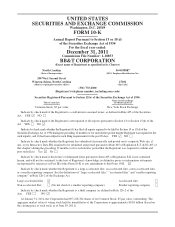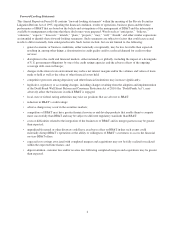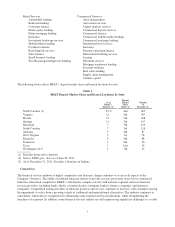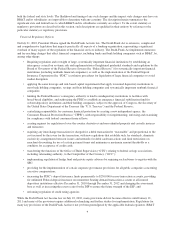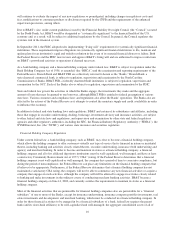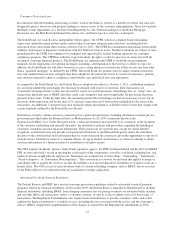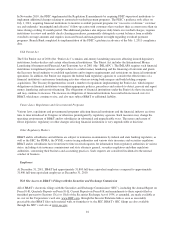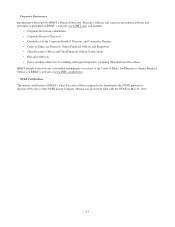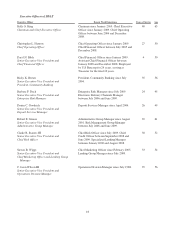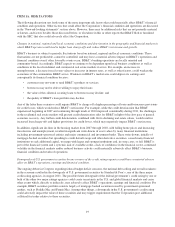BB&T 2011 Annual Report Download - page 10
Download and view the complete annual report
Please find page 10 of the 2011 BB&T annual report below. You can navigate through the pages in the report by either clicking on the pages listed below, or by using the keyword search tool below to find specific information within the annual report.will continue to evaluate the impact of any new regulations so promulgated, including changes in regulatory costs and
fees, modifications to consumer products or disclosures required by the CFPB and the requirements of the enhanced
supervision provisions, among others.
Due to BB&T’s size, under current guidelines issued by the Financial Stability Oversight Council (the “Council”) created
by the Dodd-Frank Act, BB&T would be designated as “systemically significant” to the financial health of the U.S.
economy and, as a result, will be subject to additional regulations by the Council. In general, the Council regulates the
systemic risk of the financial system.
In September 2011, the FDIC adopted rules implementing “living will” requirements for systemically significant financial
institutions. These requirements impose obligations on systemically significant financial institutions to file, maintain and
update plans for an institution’s rapid and orderly resolution in the event of its material financial distress or failure. Both
the Federal Reserve and the FDIC must review and approve BB&T’s living will and are authorized to impose restrictions
on BB&T’s growth and activities or operations if deemed necessary.
As a bank holding company and a financial holding company under federal law, BB&T is subject to regulation under the
Bank Holding Company Act of 1956, as amended, (the “BHCA”) and the examination and reporting requirements of the
Federal Reserve. Branch Bank and BB&T FSB are collectively referred to herein as the “Banks.” Branch Bank, a
state-chartered commercial bank, is subject to regulation, supervision and examination by the North Carolina
Commissioner of Banks. BB&T FSB, a federally chartered thrift institution, is subject to regulation, supervision and
examination by the OCC. Each of the Banks also is subject to regulation, supervision and examination by the FDIC.
State and federal law govern the activities in which the Banks engage, the investments they make and the aggregate
amount of loans that may be granted to one borrower, although BB&T FSB is entitled to federal preemption of various
state laws. Various consumer and compliance laws and regulations also affect the Banks’ operations. The Banks also are
affected by the actions of the Federal Reserve as it attempts to control the monetary supply and credit availability in order
to influence the economy.
In addition to federal and state banking laws and regulations, BB&T and certain of its subsidiaries and affiliates, including
those that engage in securities underwriting, dealing, brokerage, investment advisory and insurance activities, are subject
to other federal and state laws and regulations, and supervision and examination by other state and federal regulatory
agencies and other regulatory authorities, including the SEC, the Financial Industry Regulatory Authority ( “FINRA”), the
NYSE Euronext, Inc. (the “NYSE”), and various state insurance and securities regulators.
Financial Holding Company Regulation
Under current federal law, a bank holding company, such as BB&T, may elect to become a financial holding company,
which allows the holding company to offer customers virtually any type of service that is financial in nature or incidental
thereto, including banking and activities closely related thereto, securities underwriting, insurance (both underwriting and
agency) and merchant banking. In order to become and maintain its status as a financial holding company, a financial
holding company and all of its affiliated depository institutions must be well-capitalized, well-managed, and have at least
a satisfactory Community Reinvestment Act of 1977 (“CRA”) rating. If the Federal Reserve determines that a financial
holding company is not well-capitalized or well-managed, the company has a period of time to come into compliance, but
during the period of noncompliance, the Federal Reserve can place any limitations on the financial holding company that
it believes to be appropriate. Furthermore, if the Federal Reserve determines that a financial holding company has not
maintained a satisfactory CRA rating, the company will not be able to commence any new financial activities or acquire a
company that engages in such activities, although the company will still be allowed to engage in activities closely related
to banking and make investments in the ordinary course of conducting merchant banking activities. BB&T became a
financial holding company on June 14, 2000, and currently satisfies the requirements to maintain its status as a financial
holding company.
Most of the financial activities that are permissible for financial holding companies also are permissible for a “financial
subsidiary” of one or more of the Banks, except for insurance underwriting, insurance company portfolio investments, real
estate investments and development, and merchant banking, which must be conducted in a financial holding company. In
order for these financial activities to be engaged in by a financial subsidiary of a bank, federal law requires the parent
bank (and its sister-bank affiliates) to be well-capitalized and well-managed; the aggregate consolidated assets of all of
10

